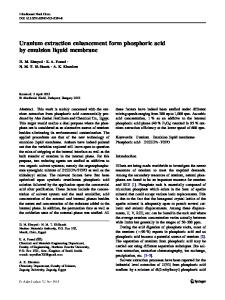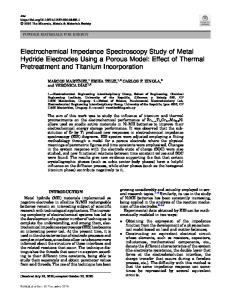Electrochemical Behavior of Porous Titanium Electrodes in Phosphoric Acid
- PDF / 651,563 Bytes
- 7 Pages / 594 x 792 pts Page_size
- 26 Downloads / 341 Views
ELECTROCHEMICAL BEHAVIOR OF POROUS TITANIUM ELECTRODES IN PHOSPHORIC ACID A. I. Kushmyruk,1 O. V. Kosohin,1, 2 O. V. Linyucheva,1 V. A. Reveko,1 and Yu. S. Miroshnychenko1 The methods of cyclic voltammetry and potentiometry are used to study the electrochemical processes running on the surface of porous titanium electrodes in solutions of phosphoric acid. In concentrated solutions, the electrode potential is equal to – 0.30–0.35 V, regardless of the method of preconditioning, which indicates the presence of corrosion activation. The difference of potentials of the cathodic and anodic peaks on cyclic voltamperograms is close to 200 mV, which allows the realization of several interconnected processes, such as the changes in the phase compositions of the surface layers on titanium and the redox processes with participation of soluble forms in the form of Ti 3+ and TiO 2+ ions. It is shown that the corrosion of titanium in strongly acidic solutions is intensified by Ti 3+ ions accumulated on the surface of the electrode due to the slow diffusion in its pores. The corrosion process is inhibited as a result of the decrease in the concentration of solution, which leads to the hydrolysis of corrosion products accompanied by the formation of insoluble compounds. Keywords: monitoring of atmospheric air, titanium, phosphoric acid, corrosion, porous electrode, titanyl ions, insoluble compounds.
The investigations of the electrochemical behavior of porous titanium in solid proton-conducting and weakly acid halogenide electrolytes [1] and in perchloric acid [2] reveal its stability in broad ranges of potentials and concentrations. This gave us a possibility to create a unified series of gas sensors of the amperometric type on the basis of porous titanium [3]. The corrosion resistance of titanium in acidic phosphate solutions is low [4]. Moreover, the literature data about the behavior of pressed porous titanium structures under the indicated conditions are absent and the results are available only for the compact metal [5–8]. The comprehensive investigations of the mechanisms of the processes running on the surface of titanium in phosphoric acid are necessary for the prediction of its behavior in the usage as a material of the currentconducting base in small-size sensor systems and electrochemical batchers of microflows. Due to small amounts of electrolytes and large surfaces of contact with air, these systems operate under the conditions of variable pH values of the electrolyte solutions and the activity of water in it under the action of atmospheric conditions. Experimental Procedure We used a titanium powder (TU U 14-10-026-98) with grain sizes of 0.05–0.10 mm and a specific surface of ∼0.2 m 2 /g [by the BET (Brunauer–Emmett–Teller) method]. The hydride preparation of titanium includes 1 2
“KPI” Ukrainian National Technical University, Kiev, Ukraine. Corresponding author; e-mail: [email protected].
Translated from Fizyko-Khimichna Mekhanika Materialiv, Vol. 51, No. 3, pp. 121–126, May–June, 2015. Original article submitted M
Data Loading...











